The Strengths Trap: How Overplaying Your Strengths Harms Trust (Part II)
 Part I of this blog described how over-emphasizing the trust-building factors in the Trust Equation without balancing your self-orientation can actually hurt your trustworthiness. It also identified many internal and external triggers that might increase self-orientation.
Part I of this blog described how over-emphasizing the trust-building factors in the Trust Equation without balancing your self-orientation can actually hurt your trustworthiness. It also identified many internal and external triggers that might increase self-orientation.
In this post, we explore specific actions you can take to avoid over-playing your strengths.
The Goldilocks Effect
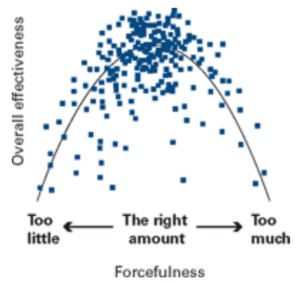
Source: “Stop Overdoing Your Strengths,” Kaplan and Kaiser, HBR Magazine, February 2009
In a Harvard Business Review article, “Stop Overdoing Your Strengths” (HBR Magazine, February 2009), authors Robert E. Kaplan and Robert B. Kaiser explored the impact of the leadership trait forcefulness on leaders’ overall effectiveness.
The plotted results of their research shows that overplaying a strength can be just as dangerous as underplaying it.
When it comes to being trustworthy, optimizing the trust equation may seem akin to the story of Goldilocks and the Three Bears: what’s too little, what’s too much, and what’s just right?
Self-orientation is an important counterweight to overplaying our trust-building strengths.
The key is balance: being able to demonstrate your strengths while keeping your self-orientation low so your overall trustworthiness increases.
Managing Self-Orientation
Lowering self-orientation to combat over-playing our strengths starts with self-awareness, noticing when internal or external pressures trigger us to focus on ourselves. Internal pressures include things like ego, fear, complacency, and personal agendas. External pressures include things like deadlines, sales and performance targets, distractions, and issues at work or home.
The antidote to overplaying our strengths is lowering self-orientation, first by recognizing when your self-orientation is high, then shifting your focus to something other than yourself.
While it sounds simple, this takes ego strength.
Once you are aware of what triggers your self-orientation to go up, you can adapt your behavior. Here are some tips to avoid over-playing each trust-building strengths:
Counter arrogance with humility.
Humility is often interpreted as timidity, but a more appropriate interpretation is recognizing how you fit into something larger than yourself. Two ways to practice humility are:
- Open-mindedness – hear others out fully and without judgment before proposing a solution. Respect their knowledge and contributions and consider their inputs. People will see your open-mindedness as increasing your credibility.
- Curiosity – explore their point of view with them before offering a different perspective. A great opening phrase might be, “Help me understand where you’re coming from.”
Counter control with tolerance.
Tolerance means accepting something you don’t agree with; it also means enduring something that feels unpleasant. When we are fully committed to one particular way of doing something, it’s hard to accept – or even see – viable alternatives. Two ways to practice tolerance are:
- Check your perspective – when you find yourself struggling because things aren’t happening the way you think they should, pause and ask yourself if your approach is the only valid one. If the overall goal is being met, even if it isn’t how you expect or want it to be, then consider changing your perspective instead of trying to change to situation.
- Grace – give others (and yourself) grace to make mistakes, to change the plan, and to be able to achieve the goal in their own way. Trusting others requires relinquishing some control. If you never give up control to someone else, what might they infer about how much you trust them?
Counter appeasement and intrusiveness with sharing.
When our natural tendency is to create connection with others, we may push too hard for them to share with us, or we may feel pressure to agree with them (regardless of our point of view). Two ways to practice sharing are:
- Go first – To avoid appeasing: if you tend to keep quiet when you disagree with what someone says, consider sharing your point of view before others share theirs so you don’t have to worry about seeming disagreeable if your point of view differs. To avoid intrusiveness: before asking someone to share something personal, share something about yourself so they feel more comfortable sharing in return.
- Create context – it’s easy to forget that others don’t necessarily know what we are thinking. Create context by framing your perspective or questions in a positive way, focusing on the mutual benefit to you and the other person. It will feel less threatening to you and to them.
To borrow from a famous C.S. Lewis quote on humility, low self-orientation is not thinking less of ourselves; it is thinking of ourselves less.
How will you lower your self-orientation to let your trust-building strengths shine through?
Trust-Based Resources to Maximize Your Team’s Potential:
- Build trust on your terms through our Self-Paced Online Courses.
- Join the crowd and sign up for one of our Public Virtual Workshops.
- Subscribe to our newsletter.
- Follow us on LinkedIn.
- Contact us directly to encourage cultural change in your organization through a trust-centric framework that pulls everyone together.

 Playing to our strengths can be seductive. We all want to feel we are presenting our best selves, and that naturally leads us to emphasize those things at which we excel. It’s often how we define our professional roles, our careers, even ourselves.
Playing to our strengths can be seductive. We all want to feel we are presenting our best selves, and that naturally leads us to emphasize those things at which we excel. It’s often how we define our professional roles, our careers, even ourselves.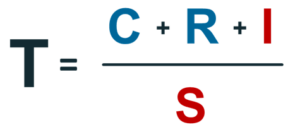

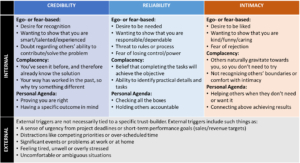
 I recently listened to Howard Stern’s interview with (Sir) Paul McCartney. One part stood out. Howard asked Paul about multiple instances where John Lennon had been cruel towards McCartney; didn’t he feel treated unfairly, hurt, resentful, Howard asked?
I recently listened to Howard Stern’s interview with (Sir) Paul McCartney. One part stood out. Howard asked Paul about multiple instances where John Lennon had been cruel towards McCartney; didn’t he feel treated unfairly, hurt, resentful, Howard asked? You may have heard the quote, “It takes years to build up trust, and only seconds to destroy it.” That saying, like several other truisms about trust, is far from true.
You may have heard the quote, “It takes years to build up trust, and only seconds to destroy it.” That saying, like several other truisms about trust, is far from true.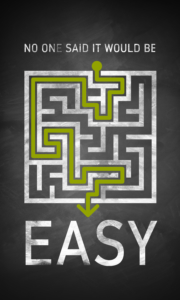 Countless studies and articles show that trust and high performing teams are interlinked. One such
Countless studies and articles show that trust and high performing teams are interlinked. One such 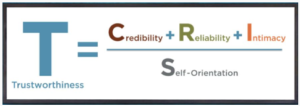
 It does not diminish the importance of reliability to say that it is the aspect of trust at which most professionals excel. This is the factor most likely to be done well by you (and your competitors). It is also the on factor of trust that requires time.
It does not diminish the importance of reliability to say that it is the aspect of trust at which most professionals excel. This is the factor most likely to be done well by you (and your competitors). It is also the on factor of trust that requires time. Credibility
Credibility
 This post was co-authored by Andrea P. Howe and
This post was co-authored by Andrea P. Howe and 